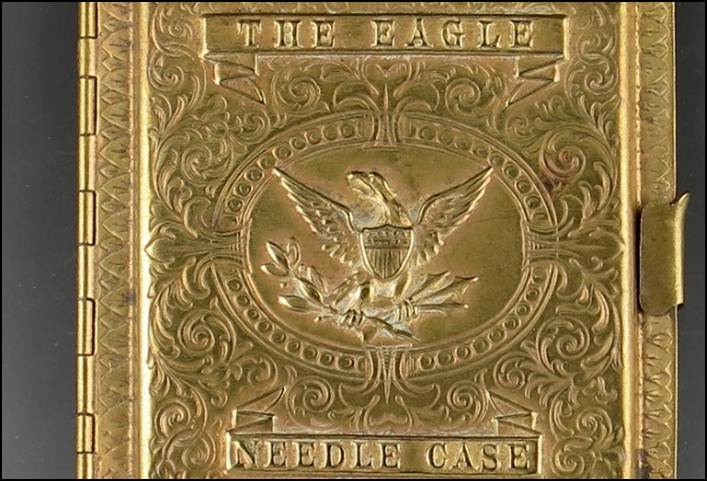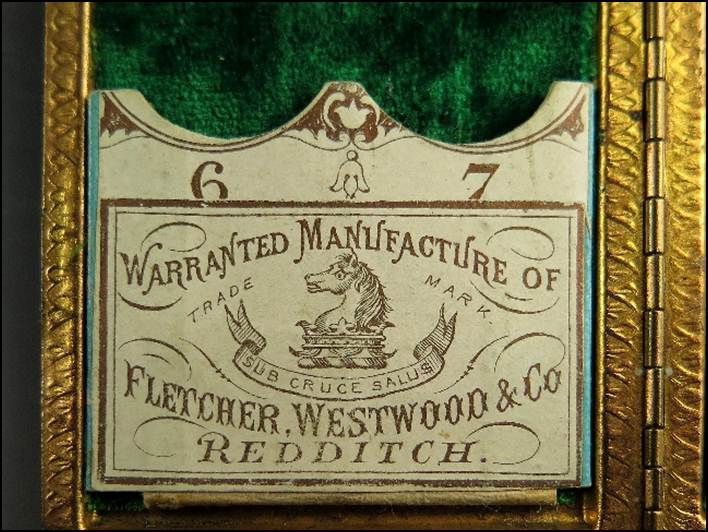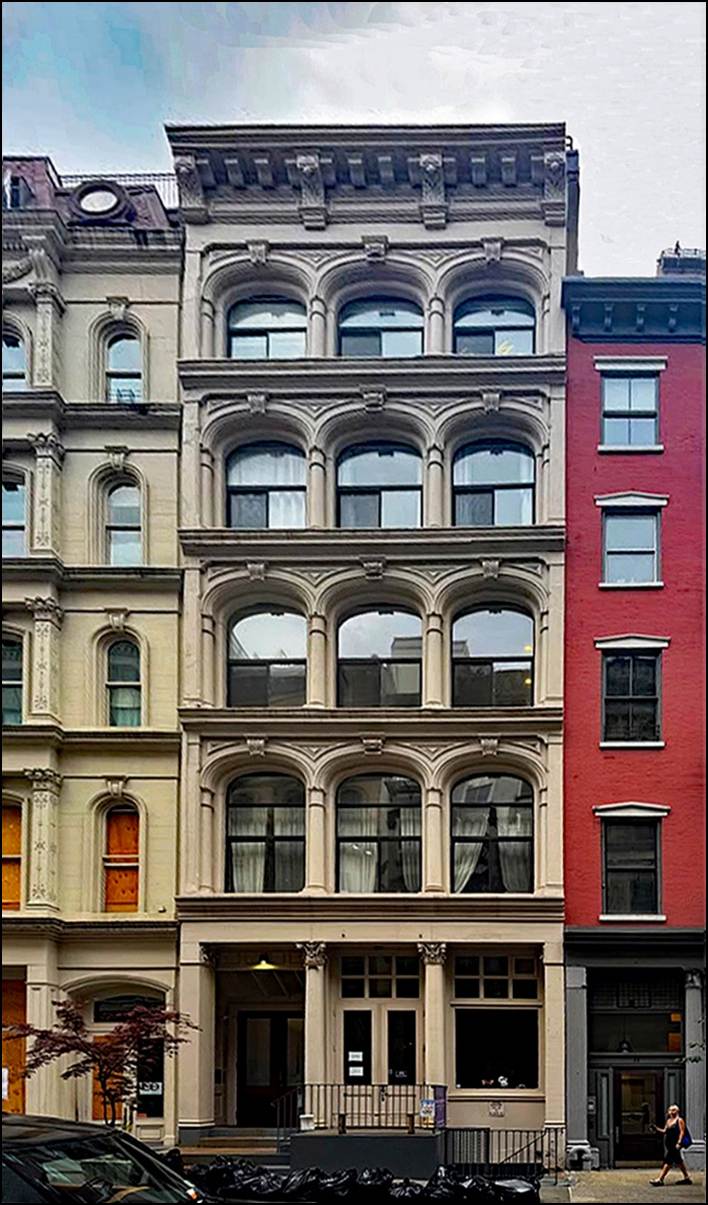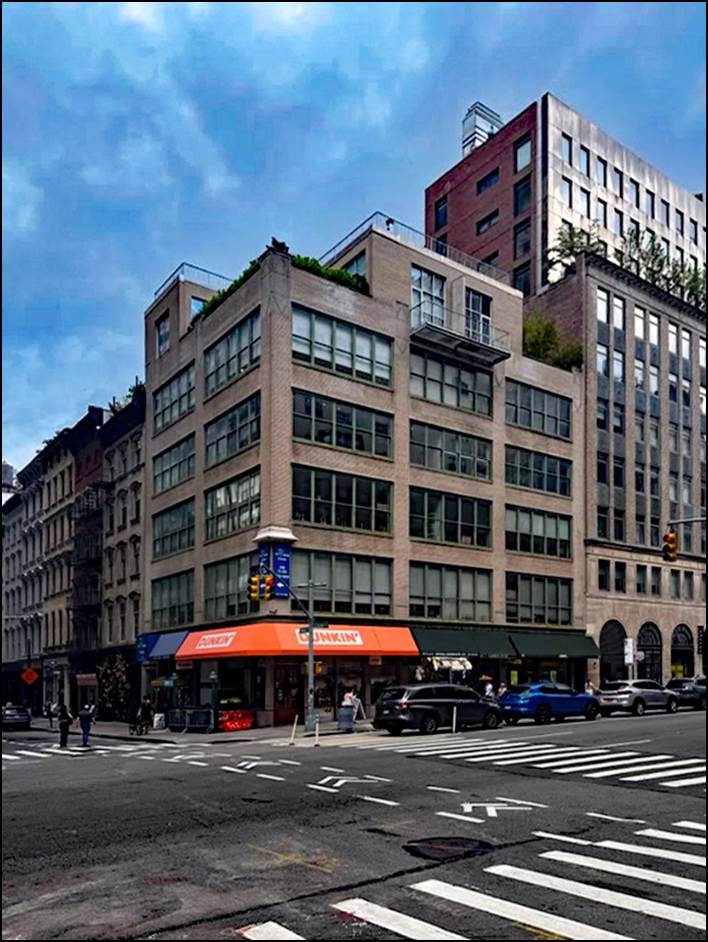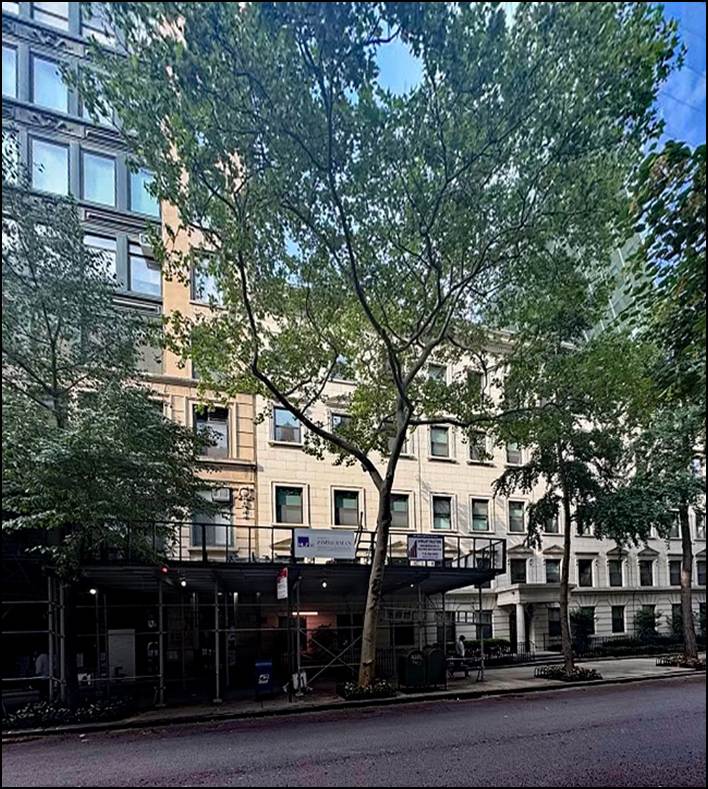R.
Moffat & Co. (aka Robert Moffat & Co.): History
(Note:
Very little information has been found regarding the firm known as R. Moffat
& Co. As a result, this chapter
will not contain a Genealogy section but will provide additional information
about the interesting Avery style needle case with the Moffat name. Also, there will be data about the company Moffat
was an agent for, Excelsior Needle Company from Torrington, Connecticut, a
major needle manufacturer in the USA during the Victorian Period).
Th
Company
 The
only advertisement found to date with this company’s name is pictured
below. It was placed in an 1873[1]
Boston, Massachusetts city directory.
Based on the advertisement, this firm was a manufacturer and importer of
sewing and machine needles and it was the sole agent for the business known as
Excelsior Needle Co. Evidently Moffat
had two stores, one at 37 Tremont Street in Boston which was managed by John
Davis and another at 5 White Street in New York managed by Robert Moffat. This was the only time the Moffat business
was found listed in a Boston city directory; however, it was listed in New York
City directories for 4 years.
The
only advertisement found to date with this company’s name is pictured
below. It was placed in an 1873[1]
Boston, Massachusetts city directory.
Based on the advertisement, this firm was a manufacturer and importer of
sewing and machine needles and it was the sole agent for the business known as
Excelsior Needle Co. Evidently Moffat
had two stores, one at 37 Tremont Street in Boston which was managed by John
Davis and another at 5 White Street in New York managed by Robert Moffat. This was the only time the Moffat business
was found listed in a Boston city directory; however, it was listed in New York
City directories for 4 years.
1873[2]
was also the first time the company was listed in a New York City
directory. That year it was recorded as
“ROBERT MOFFATT & CO” in the “Needles and Fish-Hook Manufacturers” section
at 5 White Street which was in Lower Manhattan.
In 1874[3] it
appeared as “Robert Moffat & Co., needles, 5 White”. Then in 1875[4]
the company’s address changed in one directory where it was recorded as “Robert
Moffat, needles, 128 Church, h 31E. 22d”, but in another 1875[5]
directory it was listed as “Robert Moffat & Co., imps. of needles & manufs. of machine needles, 41 White and 81 High st. Boston”. Church
Street in New York City was located about half a mile south of the White Street
location, a couple blocks west of the Old City Hall. Mr. Moffat’s home was at 31 East 22nd Street
which was two blocks southeast of Madison Square Park. In 1876[6]
the firm was listed simply as “Robert Moffat, needles, h 31 E. 22d”, however it
was no longer listed in 1877[7]. This data implies that the business was
established around 1873 with shops in New York and Boston. Although the shop in Boston had two different
addresses, it appears to only have been in existence for a couple years. The shop in New York was at one address for a
couple years and then at another address for a few years before it moved to Mr.
Moffat’s home. Although Moffat was
listed as a needle manufacturer in one directory, it seems much more likely
that the business was not actually manufacturing needles but was either selling
ones imported or manufactured by others.
Evidently the business ceased to exist by 1877.
A search was done for Robert Moffat and
John Davis in the 1870 and 1880[8]
US federal censuses for New York City and Boston and in the 1875 New York City
census. Although there were several
individuals with these names, none had an occupation related to needles or shop
keeping. Therefore, no additional
information about this company or its owners has been found. However, it should be noted that Moffat is a
Scottish name and most of the immigrants[9]
to the USA with that name either came from Scotland or neighboring Ireland.
The
American Eagle Needle Case[10]
To
date only one Avery style needle case has been found stamped with the R. Moffat
name. It is the American Eagle needle
case. Prior to this research it was
assumed that this needle case was registered by W. Hall & Co. of Studley,
UK in 1880 as the design registration, #354008 drawing seen here, has a close
resemblance to this  actual
needle case. The design is of a flat
semi-square box with a narrow pattern around the edges, a circular design in
the center and a tiny catch on the right side which allowed the case to be
securely closed. When compared to the
American Eagle needle case, pictured below, the basic design matches. However, now we know R. Moffat & Co. was
no longer in business by 1877 and an actual needle case known as the
Chinoiserie[11] that
exactly matches this design registration exists. It seems much more likely that the Moffat
needle case came from a different design that was registered and manufactured
before 1877. Apparently, this needle
case was made specifically for the American market because the front cover
contains the Great Seal of the United States of America. Also, the back cover includes the Royal Coat
of Arms of the UK and the words “By Royal Letters Patent” which indicates it
was registered in the UK and was probably manufactured in the Birmingham area
as that is where most Avery style needle cases were made.
actual
needle case. The design is of a flat
semi-square box with a narrow pattern around the edges, a circular design in
the center and a tiny catch on the right side which allowed the case to be
securely closed. When compared to the
American Eagle needle case, pictured below, the basic design matches. However, now we know R. Moffat & Co. was
no longer in business by 1877 and an actual needle case known as the
Chinoiserie[11] that
exactly matches this design registration exists. It seems much more likely that the Moffat
needle case came from a different design that was registered and manufactured
before 1877. Apparently, this needle
case was made specifically for the American market because the front cover
contains the Great Seal of the United States of America. Also, the back cover includes the Royal Coat
of Arms of the UK and the words “By Royal Letters Patent” which indicates it
was registered in the UK and was probably manufactured in the Birmingham area
as that is where most Avery style needle cases were made.
The front of this needle case contains the words
“R. MOFFAT & Co.” in a small rectangular boxed area near the top and “NEW
YORK” in the same type of boxed area near the bottom. In the center circular shaped section is the
Great Seal of America surrounded by an engraved  scroll
scroll  pattern. In 1782, six
years after the American Revolutionary War ended, the bald eagle was selected
to become the official seal of the United States because it symbolized strength
and freedom. An example of the Great Seal
is pictured[12]
below on the right so it can be compared to the detail of the seal symbol on
the needle case. The eagle’s wings are
pattern. In 1782, six
years after the American Revolutionary War ended, the bald eagle was selected
to become the official seal of the United States because it symbolized strength
and freedom. An example of the Great Seal
is pictured[12]
below on the right so it can be compared to the detail of the seal symbol on
the needle case. The eagle’s wings are  outstretched,
and one claw is holding a bundle of arrows and the other an olive branch. The arrows represent the 13 original states
and the olive branch symbolized peace.
On the bird’s breast is a shield composed of red and white stripes under
a blue band representing the American flag.
The eagle clutches a scroll in its mouth with the words “Epluribus
outstretched,
and one claw is holding a bundle of arrows and the other an olive branch. The arrows represent the 13 original states
and the olive branch symbolized peace.
On the bird’s breast is a shield composed of red and white stripes under
a blue band representing the American flag.
The eagle clutches a scroll in its mouth with the words “Epluribus  unum”
which means “Out of Many, One”. Over the bald eagle’s head there is a
circular glory (a halo appearing around a shadow of an object) with 13 stars on
a blue background. These 13 stars also
represent the first thirteen states in America.
As you can see the seal on the needle case pretty much matches the
official seal but is missing the scroll and circular area above the eagle’s
head.
unum”
which means “Out of Many, One”. Over the bald eagle’s head there is a
circular glory (a halo appearing around a shadow of an object) with 13 stars on
a blue background. These 13 stars also
represent the first thirteen states in America.
As you can see the seal on the needle case pretty much matches the
official seal but is missing the scroll and circular area above the eagle’s
head.
On the other side of the needle case the words “BY ROYAL
LETTERS” are in a small rectangular boxed area near the top, and the word
“PATENT” is in the same type of boxed area near the bottom. The circular shaped section in the middle
contains the Royal Coat of Arms which consists of six parts surrounded by an
engraved  scroll
pattern. The actual coat of arms is
pictured below[13]
on the right so it can be compared to the detailed photograph of the coat of
arms on the needle case. In the center
is a shield divided into four parts with the Coat of Arms of England on the top
left and bottom right, the Coat of Arms of Scotland on the top right, and the
Coat of Arms of Ireland on the bottom left.
The Coat of Arms of England consists of a red background with three gold
lions with blue claws and tongues. The
lions are depicted sideways with their right front paws raised and their heads
facing the viewer. The Coat of Arms of
Scotland consists of a red lion rearing on its hind legs surrounded by a red
double border decorated with fleurs-de-lis, all on a gold background. And the Coat of Arms of Ireland consists of a
gold harp with silver strings on a blue background. On the left side supporting the shield is a lion rampant which
scroll
pattern. The actual coat of arms is
pictured below[13]
on the right so it can be compared to the detailed photograph of the coat of
arms on the needle case. In the center
is a shield divided into four parts with the Coat of Arms of England on the top
left and bottom right, the Coat of Arms of Scotland on the top right, and the
Coat of Arms of Ireland on the bottom left.
The Coat of Arms of England consists of a red background with three gold
lions with blue claws and tongues. The
lions are depicted sideways with their right front paws raised and their heads
facing the viewer. The Coat of Arms of
Scotland consists of a red lion rearing on its hind legs surrounded by a red
double border decorated with fleurs-de-lis, all on a gold background. And the Coat of Arms of Ireland consists of a
gold harp with silver strings on a blue background. On the left side supporting the shield is a lion rampant which  represents England and on the right a unicorn which
represents Scotland. Both the lion and
the unicorn are standing on a small frame containing the sovereign’s motto in
French “Dieu et mon droit” which means
represents England and on the right a unicorn which
represents Scotland. Both the lion and
the unicorn are standing on a small frame containing the sovereign’s motto in
French “Dieu et mon droit” which means “God and my
right”. Around the shield is a belt or strap with the motto “Honi
soit qui mal y pense” which
means "Evil to him who evil thinks", the symbol of the Order of
the Garter. Above the shield is a gold
helmet with the crest and the royal crown topped with a golden crowned lion
with mantling (a piece of ornamental drapery) on the sides. As you can see
the coat of arms on the needle case also pretty much matches the official coat
of arms only the belt around the shield and the helmet below the crown and the
lion above the crown with the mantling are missing.
“God and my
right”. Around the shield is a belt or strap with the motto “Honi
soit qui mal y pense” which
means "Evil to him who evil thinks", the symbol of the Order of
the Garter. Above the shield is a gold
helmet with the crest and the royal crown topped with a golden crowned lion
with mantling (a piece of ornamental drapery) on the sides. As you can see
the coat of arms on the needle case also pretty much matches the official coat
of arms only the belt around the shield and the helmet below the crown and the
lion above the crown with the mantling are missing.
To
date only one other example of the American Eagle needle case has been found
with a small difference. Rather than
having the R. Moffat & Co. name and New York engraved onto the brass in the
small rectangular boxes near the top and bottom front, this other version
contains the words “THE EAGLE” at the top and “NEEDLE CASE” near the
bottom. Also, these words are actually stamped onto the brass rather than being
engraved. This seems to imply that this
needle case was originally designed to have those two rectangular sections on
the front blank so that way they could be engraved with a specific company name
or stamped with The Eagle name depending upon which needle manufacturer ordered
the needle case so they could sell it with their needles inside. A photograph of this front can be found in
the Images section of this chapter.
A view of the
interior of the R. Moffat & Co. needle case is seen here which contains
pasteboard sections for 6, 7, 8 and 9 sized needles. Because there is no reference to the needle
manufacturer, only the words “Best Selected Oval Eyed Needles” it is unclear
whose needles  were originally inside. Perhaps Moffat filled these slots
with needles the company imported or ones that were manufactured by the
Excelsior Needle Company since Moffat was the sole agent for that company. To date at least two of these American Eagle
needle cases stamped with The Eagle Needle Case name had different pasteboard
interiors. One was printed with the
words “W. Woodfield & Sons Eastmore Works,
Redditch, Egg Eyed Needles” and the other with “Warranted Manufacture of
Fletcher, Westwood & Co, Redditch”. Apparently these two companies also sold
their needles in this needle case to others in America.
were originally inside. Perhaps Moffat filled these slots
with needles the company imported or ones that were manufactured by the
Excelsior Needle Company since Moffat was the sole agent for that company. To date at least two of these American Eagle
needle cases stamped with The Eagle Needle Case name had different pasteboard
interiors. One was printed with the
words “W. Woodfield & Sons Eastmore Works,
Redditch, Egg Eyed Needles” and the other with “Warranted Manufacture of
Fletcher, Westwood & Co, Redditch”. Apparently these two companies also sold
their needles in this needle case to others in America.
The
Excelsior Needle Company[14]
This
sewing machine company was established in 1866 in Torrington, Connecticut which
is located 109 miles northeast of central New York City and 130 miles southwest
of Boston. The firm was created after
two men from Connecticut invented a machine in 1864 for compressing steel which
produced better shaped pieces of metal for sewing needles. These men sold their patent to several other
men from Torrington who established the Excelsior Needle Company and who
dramatically improved the
 compressing machine’s functions. By 1869 the business moved to a new location
where a factory was built on Church Street in Torrington after having increased
its capital stock from $2,000 to $25,000.
In the mid 1870’s the firm was producing over 30,000 needles a day or
four or five million a year because their needles were being purchased by
almost every sewing machine company that did
not make their own needles. By the
1890’s the business had expanded considerable by acquiring other needle
businesses throughout the United States and building a new factory in Torrington
on Field Street. The firm also
diversified by adding a variety of sewing machine needles, knitting machine
needles, heavy hook needles used in shoemaking and spokes for bicycle wheels to
their product line. At one point their
Torrington factory employed 650-700 workers which increased to over 1,000 over
the years. In 1898 the firm was absorbed
into the newly created Torrington Company of Maine but it retained its
corporate name and local management.
Then in 1917 it became part of the Torrington Company of Connecticut,
and the factory became known as Excelsior Plant. Over the years the production of sewing
machine needles became less important and needle bearings, which were used for
military aircraft bombers, became the company’s main product line after World
War II. The less profitable needle side
of the business was closed in 1980.
compressing machine’s functions. By 1869 the business moved to a new location
where a factory was built on Church Street in Torrington after having increased
its capital stock from $2,000 to $25,000.
In the mid 1870’s the firm was producing over 30,000 needles a day or
four or five million a year because their needles were being purchased by
almost every sewing machine company that did
not make their own needles. By the
1890’s the business had expanded considerable by acquiring other needle
businesses throughout the United States and building a new factory in Torrington
on Field Street. The firm also
diversified by adding a variety of sewing machine needles, knitting machine
needles, heavy hook needles used in shoemaking and spokes for bicycle wheels to
their product line. At one point their
Torrington factory employed 650-700 workers which increased to over 1,000 over
the years. In 1898 the firm was absorbed
into the newly created Torrington Company of Maine but it retained its
corporate name and local management.
Then in 1917 it became part of the Torrington Company of Connecticut,
and the factory became known as Excelsior Plant. Over the years the production of sewing
machine needles became less important and needle bearings, which were used for
military aircraft bombers, became the company’s main product line after World
War II. The less profitable needle side
of the business was closed in 1980.
R.
Moffat & Co. (aka Robert Moffat & Co.): Images



